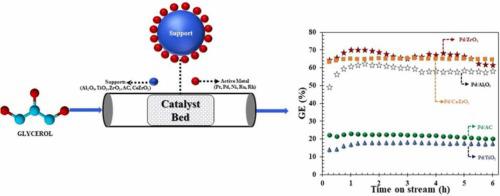The Journal of Supercritical Fluids ( IF 3.4 ) Pub Date : 2021-10-22 , DOI: 10.1016/j.supflu.2021.105459 Nandana Chakinala 1 , Anand G. Chakinala 1

|
The objective of this study is to maximize the hydrogen yield from hydrothermal reforming of glycerol by screening different catalysts. Catalysts with different active metals (Platinum, Ruthenium, Palladium, Nickel and Rhodium) on alumina support and palladium with different supports (Alumina, Titania, Zirconia, Activated Carbon, Ceria modified Zirconia) were synthesized, characterized, and tested at hydrothermal conditions (450 °C and 250 bar) for glycerol reforming up to 6 h duration. With different metals, maximum carbon gasification efficiency of 70% and hydrogen yield of 2.023 mol/mol was achieved with platinum metal while the lowest carbon gasification efficiency of ~ 7.5 was obtained with nickel-based catalyst with a very low hydrogen yields of 0.021 mol/mol. Since, the amount of active metal loading (~ 1.5 wt%) was very low, in the case of nickel it led to inactive and stable phase of NiAl2O4 having poor catalytic performance. With different supports, maximum carbon gasification efficiency of ~ 65% and hydrogen yield of 2.475 mol/mol was obtained with ceria modified zirconia support. Lowest conversion and hydrogen yield of 17.3% and 0.155 respectively were achieved with titania support. The order of gasification efficiency with respect to different supports was in the order of CeZrO2 ~ ZrO2 > Al2O3 > AC > TiO2. Analysis of the spent catalysts showed significant phase change of alumina support from γ-Al2O3 to α-Al2O3 with maximum coke deposition evident from the thermogravimetric analysis without any catalyst deactivation. These findings provide new opportunities for rational design of catalyst for the hydrothermal conversion of glycerol to hydrogen rich product gas.
中文翻译:

热压缩水中甘油的催化重整:金属和载体的作用
本研究的目的是通过筛选不同的催化剂使甘油水热重整的氢气产率最大化。在氧化铝载体上具有不同活性金属(铂、钌、钯、镍和铑)和钯具有不同载体(氧化铝、二氧化钛、氧化锆、活性炭、二氧化铈改性氧化锆)的催化剂被合成、表征并在水热条件下进行测试 (450 °C 和 250 bar),用于甘油重整长达 6 小时。对于不同的金属,铂金属的碳气化效率最高为 70%,氢气产率为 2.023 mol/mol,而镍基催化剂的碳气化效率最低,为 0.021 mol/mol,氢气产率非常低,为 0.021 mol/mol摩尔。由于活性金属负载量(~1.5 wt%)非常低,2 O 4具有较差的催化性能。在不同的载体下,用氧化铈改性的氧化锆载体获得了~65%的最大碳气化效率和2.475 mol/mol的氢气产率。使用二氧化钛载体实现了分别为 17.3% 和 0.155 的最低转化率和氢气产率。不同载体的气化效率顺序为CeZrO 2 ~ ZrO 2 > Al 2 O 3 > AC > TiO 2。对废催化剂的分析表明氧化铝载体从 γ-Al 2 O 3到 α-Al 2 O 3发生了显着的相变从热重分析中可以看出最大的焦炭沉积,而没有任何催化剂失活。这些发现为合理设计将甘油水热转化为富氢产品气的催化剂提供了新的机会。











































 京公网安备 11010802027423号
京公网安备 11010802027423号